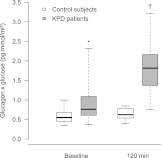β- and α-cell dysfunctions in africans with ketosis-prone atypical diabetes during near-normoglycemic remission
- PMID: 22933436
- PMCID: PMC3526247
- DOI: 10.2337/dc12-0798
β- and α-cell dysfunctions in africans with ketosis-prone atypical diabetes during near-normoglycemic remission
Abstract
Objective: Ketosis-prone atypical diabetes (KPD) is a subtype of diabetes in which the pathophysiology is yet to be unraveled. The aim of this study was to characterize β- and α-cell functions in Africans with KPD during remission.
Research design and methods: We characterized β- and α-cell functions in Africans with KPD during remission. The cohort comprised 15 sub-Saharan Africans who had been insulin-free for a median of 6 months. Patients in remission were in good glycemic control (near-normoglycemic) and compared with 15 nondiabetic control subjects matched for age, sex, ethnicity, and BMI. Plasma insulin, C-peptide, and glucagon concentrations were measured in response to oral and intravenous glucose and to combined intravenous arginine and glucose. Early insulin secretion was measured during a 75-g oral glucose tolerance test. Insulin secretion rate and glucagon were assessed in response to intravenous glucose ramping.
Results: Early insulin secretion and maximal insulin secretion rate were lower in patients compared with control participants. In response to combined arginine and glucose stimulation, maximal insulin response was reduced. Glucagon suppression was also decreased in response to oral and intravenous glucose but not in response to arginine and insulin.
Conclusions: Patients with KPD in protracted near-normoglycemic remission have impaired insulin response to oral and intravenous glucose and to arginine, as well as impaired glucagon suppression. Our results suggest that β- and α-cell dysfunctions both contribute to the pathophysiology of KPD.
Figures


Comment in
-
Ketosis-prone atypical diabetes: glucagon is there, too.Diabetes Care. 2013 Jan;36(1):8-10. doi: 10.2337/dc12-1696. Diabetes Care. 2013. PMID: 23264286 Free PMC article. No abstract available.
Similar articles
-
Multitissue insulin resistance despite near-normoglycemic remission in Africans with ketosis-prone diabetes.Diabetes Care. 2008 Dec;31(12):2332-7. doi: 10.2337/dc08-0914. Epub 2008 Sep 22. Diabetes Care. 2008. PMID: 18809633 Free PMC article.
-
Effects of intravenous glucose load on insulin secretion in patients with ketosis-prone diabetes during near-normoglycemia remission.Diabetes Care. 2010 Apr;33(4):854-60. doi: 10.2337/dc09-1687. Epub 2010 Jan 12. Diabetes Care. 2010. PMID: 20067967 Free PMC article. Clinical Trial.
-
Ketosis-prone atypical diabetes: glucagon is there, too.Diabetes Care. 2013 Jan;36(1):8-10. doi: 10.2337/dc12-1696. Diabetes Care. 2013. PMID: 23264286 Free PMC article. No abstract available.
-
Assessment of residual insulin secretion in diabetic patients using the intravenous glucagon stimulatory test: methodological aspects and clinical applications.Diabetes Metab. 1996 Dec;22(6):397-406. Diabetes Metab. 1996. PMID: 8985647 Review.
-
Remission in Ketosis-Prone Diabetes.Endocrinol Metab Clin North Am. 2023 Mar;52(1):165-174. doi: 10.1016/j.ecl.2022.06.005. Epub 2022 Nov 4. Endocrinol Metab Clin North Am. 2023. PMID: 36754492 Review.
Cited by
-
Clinical and biological characteristics of diabetic patients under age 40 in Cameroon: relation to autoantibody status and comparison with Belgian patients.Diabetes Res Clin Pract. 2014 Jan;103(1):97-105. doi: 10.1016/j.diabres.2013.11.013. Epub 2013 Nov 20. Diabetes Res Clin Pract. 2014. PMID: 24332797 Free PMC article.
-
Ketosis onset type 2 diabetes had better islet β-cell function and more serious insulin resistance.J Diabetes Res. 2014;2014:510643. doi: 10.1155/2014/510643. Epub 2014 Apr 13. J Diabetes Res. 2014. PMID: 24829925 Free PMC article.
-
Ketosis-Prone Diabetes (Flatbush Diabetes): an Emerging Worldwide Clinically Important Entity.Curr Diab Rep. 2018 Oct 2;18(11):120. doi: 10.1007/s11892-018-1075-4. Curr Diab Rep. 2018. PMID: 30280274 Free PMC article. Review.
-
Stimulated UCPCR Levels Are Lower in People With Type 1 Diabetes Than in Other Diabetes Types in Sub-Saharan Africa: Results From a Preliminary Cross-Sectional Study.Front Public Health. 2022 Apr 8;10:866107. doi: 10.3389/fpubh.2022.866107. eCollection 2022. Front Public Health. 2022. PMID: 35462815 Free PMC article.
-
Acute phase ketosis-prone atypical diabetes is associated with a pro-inflammatory profile: a case-control study in a sub-Saharan African population.J Diabetes Metab Disord. 2018 Mar 29;17(1):37-43. doi: 10.1007/s40200-018-0336-8. eCollection 2018 Jun. J Diabetes Metab Disord. 2018. PMID: 30288384 Free PMC article.
References
-
- Sobngwi E, Mauvais-Jarvis F, Vexiau P, Mbanya JC, Gautier JF. Diabetes in Africans. Part 2: Ketosis-prone atypical diabetes mellitus. Diabetes Metab 2002;28:5–12 - PubMed
-
- Umpierrez GE, Smiley D, Kitabchi AE. Narrative review: ketosis-prone type 2 diabetes mellitus. Ann Intern Med 2006;144:350–357 - PubMed
-
- Umpierrez GE, Casals MM, Gebhart SP, Mixon PS, Clark WS, Phillips LS. Diabetic ketoacidosis in obese African-Americans. Diabetes 1995;44:790–795 - PubMed
-
- Balasubramanyam A, Zern JW, Hyman DJ, Pavlik V. New profiles of diabetic ketoacidosis: type 1 vs type 2 diabetes and the effect of ethnicity. Arch Intern Med 1999;159:2317–2322 - PubMed
Publication types
MeSH terms
Substances
LinkOut - more resources
Full Text Sources
Medical

